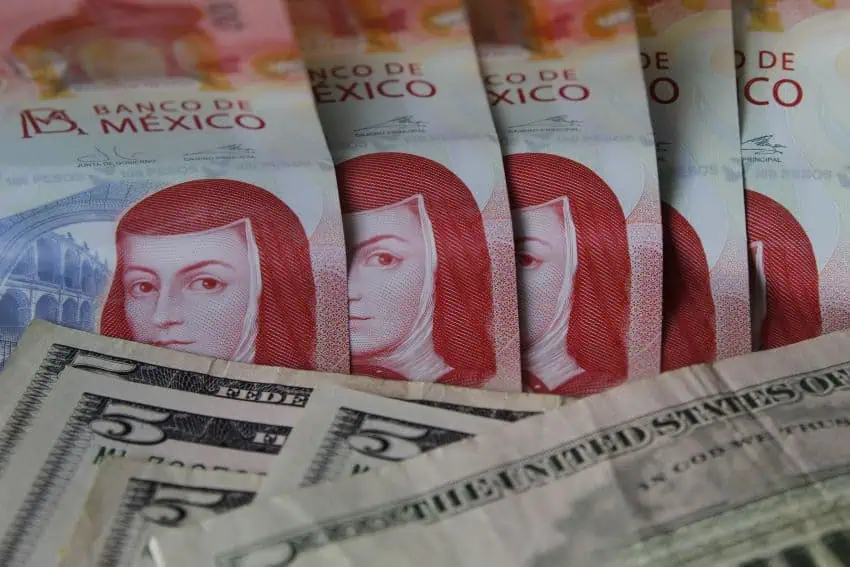The Mexican peso strengthened to below 18 pesos per U.S. dollar on Monday morning after data showed higher-than-expected inflation in the first half of June.
The peso hit 17.88 pesos to the dollar at 11:45 a.m. Mexico City time, just hours after Mexico's national statistics institute, INEGI, reported that annual headline inflation for the first 15 days of June was 4.78%, up from 4.59% in the previous two weeks and 4.69% for all of May, according to Bloomberg data.
![]()
![]() High inflation is also helping to strengthen the peso, and the Bank of Mexico is likely to keep interest rates at 11%. (Cuartoscuro)
High inflation is also helping to strengthen the peso, and the Bank of Mexico is likely to keep interest rates at 11%. (Cuartoscuro)
The currency, which closed at 18.11 to the dollar on Friday, also benefited from some general weakness in the dollar.
Inflation for the first half of the month was 0.05 percentage point above the 4.73% median forecast of analysts surveyed by Bloomberg.
The better-than-expected figure raises the likelihood that the Bank of Mexico's board of governors, which targets inflation at 3%, will decide to keep the central bank's official interest rate unchanged at 11% when it meets on Thursday.
Such a decision would favor the peso as it would not narrow the gap between the Bank of Mexico's base rate and that of the U.S. Federal Reserve, which is currently set in the 5.25% to 5.5% range.
![]()
![]() The peso has been trending higher since Sheinbaum announced his cabinet appointments last week. (Cuartoscuro)
The peso has been trending higher since Sheinbaum announced his cabinet appointments last week. (Cuartoscuro)
The peso has long benefited from the wide difference between the two countries' official interest rates, but it took a hit after Mexico's June 2 elections put the ruling Morena party in a strong position to approve a package of constitutional reforms that President Andrés Manuel López Obrador submitted to Congress earlier this year.
The peso strengthened last weekend after President-elect Claudia Scheinbaum announced her first cabinet appointees, including Economy Minister Marcelo Ebrard. But despite further gains on Monday morning, the currency remains more than 5 percent weaker than before the election.
Rising prices for fresh food and services will fuel inflation
Inflation for fruits, vegetables and services remains high, according to INEGI data.
Fruit and vegetable prices increased by 17.28% in the first 15 days of this month compared to the first half of June 2023.
The annual inflation rate for agricultural products overall was 8.99%, held down by a relatively low inflation rate for meat, at 2.46%.
Prices of some fresh produce have increased significantly compared to the previous two weeks as drought continues to affect food prices.
For example, chayote prices have increased 79% since late May, oranges have increased 19%, lettuce and cabbage have increased 15%, banana prices have soared 11%, and avocados have increased nearly 8%.
Meanwhile, annual inflation in the services sector was 5.19% in the first half of June, while processed foods, beverages and tobacco rose 4.28%.
Electricity prices, including gasoline, rose 4.74 percent, while non-food items increased 2.18 percent.
Annual core inflation, which excludes closely watched volatile food and energy prices, stood at 4.17% in the first half of June, up from 4.11% in the second half of May but down from 4.21% overall last month.
![]()
![]() Inflation has made cilantro more expensive, so some taco stands are now offering “cilantro-free” tacos. (Cuartoscuro)
Inflation has made cilantro more expensive, so some taco stands are now offering “cilantro-free” tacos. (Cuartoscuro)
That was slightly below the 4.18% median estimate of analysts surveyed by Bloomberg.
Jessica Roldan, chief economist at Finamex Securities, said headline inflation “was worse than expected due to much stronger-than-expected increases in fruits and vegetables.”
The impact of these prices on inflation “may last longer due to the prolonged dry weather so far, but also other factors such as increased rainfall in some parts of the country that may now affect crops,” she said.
The recent depreciation of the peso will also influence the central bank's interest rate decision.
In addition to inflation, which has been rising since March, Mexico's bank (Banxico) “also needs to consider the risk of higher inflation due to the weaker peso,” Bloomberg reported.
“Given Mexico's continued strength in headline services inflation in the first half of June, the post-election peso's weakness and heightened political uncertainty, the Bank of Mexico is unlikely to resume its easing cycle at its board meeting on Thursday,” Kimberly Sparfechter, emerging markets economist at London-based Capital Economics, wrote in a note.
Gabriela Siller, director of economic analysis at Banco de Mexico-Base, believes a majority of the central bank's board of governors will vote to keep interest rates at 11 percent, due to factors including the recent weakening of the peso.
“A sharp depreciation of the peso could create inflationary pressures, but the magnitude may not always be the same, so it would be prudent to wait and see,” she said.
“Going forward, we are thinking…” [the Banxico board is] “We plan to make two more cuts this year, but we will do so when conditions improve towards the end of the year,” Shiller said.
The bank cut interest rates for the first time in March from a record high of 11.25%.
Another item the central bank's board will consider this Thursday will be data showing that Mexico's economy grew just 0.9% year-on-year in April, down from 3.3% in March.
Reports from El Economista, Yahoo and El Financiero



